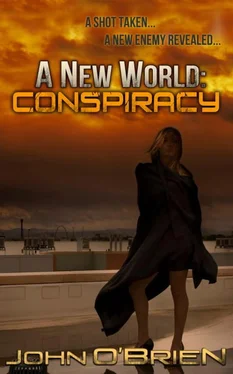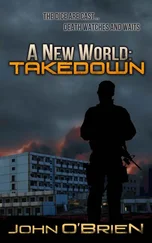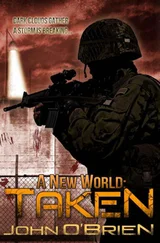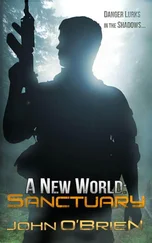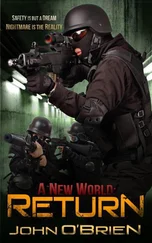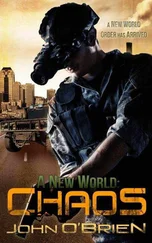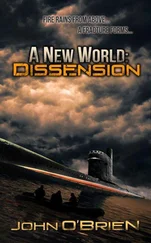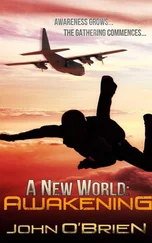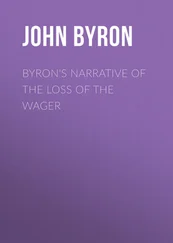“Anything?” Franklin whispers across the radio.
Krandle shakes his head as he continues to look into the building. Looking at the grit-covered sidewalk at his feet, there aren’t any tracks or other disturbances that would indicate something had been along this way recently. Snapping off his light, he backs from the window to his gathered team.
“Okay, let’s keep going. Miller, keep a sharp eye behind us.”
Each of them cast leery glances at the structure as they rise to proceed on their journey. Houses in the same condition as the run-down buildings lie across the road. Most are barely visible through the overgrown bushes and weeds. Several seem on the verge of collapse with one having its roof in a concave shape, ready to fall in on itself with the next strong gust of wind. More than a few have rope chains stretched across overgrown driveways. The lack of birds in the area is strange. This is the first time Krandle has been close to a shoreline and not witnessed gulls in the area — soaring aloft or on some perch looking for scraps of food.
“Everyone halt,” Krandle whispers into the mic.
He waves Franklin to his position. “Are you still carrying the portable chemical detector?”
“Yes,” Franklin answers, taking off his small pack and digging through it.
“This will take a few minutes,” Franklin says, removing an olive drab plastic unit.
“Oh shit,” Speer comments, seeing what Franklin has brought out.
“Easy now. We’d have already felt something if there was anything here. I just want to make sure,” Krandle says, briefly explaining his uneasiness with the lack of any life around, mentioning in particular the lack of gulls.
Minutes slowly tick by as the unit boots up and it begins to take samples from the air. Seconds are counted by the beads of sweat that form on all of them. Krandle and Franklin squat in the center of a small perimeter formed by the other four. Speer, Blanchard, Miller, and Ortiz focus their attention outward. More than once, they all glance at the building from where the noise came and sneak peeks toward Krandle, waiting for word. Like watching water come to a boil, Krandle and Franklin stare at the device.
At long last, the unit gives a beep and Franklin brings the display closer.
“All clear,” he says loudly enough for all to hear, but not so loud that his voice carries.
A collective sigh passes through the team — an almost physical release.
“Then why aren’t there any gulls?” Krandle mutters under his breath as Franklin stows the unit and makes ready.
With a wave of his hand, Krandle motions for Speer to continue.
The hill that is their goal is to their front left in the distance. They’ll have to progress through the town in order to reach it. Several blocks later, Speer turns left down a side street. The gusts at intervals bring the smell of the sea. The clouds overhead barely move and seem content to stay where they are.
They enter a part of town that is geared toward the tourist trade. Small shops line the road, most with their windows broken. Barely seen are signs denoting kites for sale or bikes to rent. Salt water taffy and other candy shops are prevalent along with the usual trinket and T-shirt shops. One shop advertises artwork and another, blown glass. Sand is piled against the buildings and in the small doorways. In places, the layers of sand and grit show pathways through them. There aren’t any tracks, but the covering is uneven.
Of course, it may not be made by anyone , Krandle thinks, stopping to examine them. It could be created by the wind swirling through the area .
The streets are mostly clear of vehicles and drifts pile high, in some places almost reaching halfway up the structures. Scraps of paper and other light debris lay scattered across the avenues they pass. Gusts of wind swirl through the streets of this seemingly abandoned town, picking up the loose fragments and sweeping them to a new resting place. Faintly, Krandle hears the harsh cries of gulls ahead.
A couple of blocks later, Speer radios that he’s spotted a body ahead. With caution, they approach.
The body lies in a broken window, half in and half out of what used to be a café. The head and forearms are buried in a sand drift outside of the restaurant with the legs draped on the inside. Putting the men on watch, Krandle looks closer. The jeans are darkly stained. It takes him a moment to realize that the jeans are pressed flat, meaning the legs aren’t attached to the body. Grit covers the diner floor, but he eventually sees a few bones scattered within. In one place, a shin bone stripped clean of flesh lies with a tennis shoe still attached. Moving some of the sand away from the upper torso, he sees that the flesh has been ripped from the bones. Only a few pieces of desiccated flesh, sinew, and hair remain.
Speer calls with the sighting of another body farther up the street. The new body is in the same condition — dried out with most of the body torn apart. The farther into town the team proceeds, the more bodies they find. Some just inside the buildings, others in sand drifts, and yet more just lying in the street. Some of the bodies haven’t been mutilated. Just like in the other town they visited, Krandle guesses the ones still intact are night runners.
The team warily proceeds in the narrowed street between the shops. The sound of the gulls increases with each step they travel. It isn’t a cacophony of sound, but single, distinct cries. They pass bits of strewn clothing, some mere scraps poking out of sand. The whole team is silent and walks with trepidation, wondering what they’ll find farther in. Fingers stroke trigger guards with nervousness. They are tense and alert, ready to unleash fury in a given moment.
Pant legs and sleeves flap in the periodic flurries of wind winding through the streets. It stirs the layer of sand, creating new designs with each draft. Krandle again finds it hard to tell if the trails through the grit are from the passage of something or just the wind drawing patterns. He has Speer and Miller take closer looks but even they can’t tell.
Gone is the joking around. Solemn game faces are etched on the entire team. Thinned lips and watchful eyes denote the tension in each of them as they attempt to peer through the darkened veils into the depths of each shop. Krandle feels his heart hammering. It’s a feeling he became used to long ago and even welcomes. With it, he knows his senses are sharpened and reactions quicker. He fully expects to hear a noise from each store like the one they heard at the auto repair garage, but there is only the soft whish of wind and the occasional cry of a gull.
The area opens as they emerge into a plaza with a small fountain in the center, surrounded by a low concrete wall. The rest of the plaza is filled with tall grass swaying with each breath of wind. Krandle can imagine the finely manicured lawn with tourists taking their ease on its soft surface — the gentle murmur of the fountain in the background.
Adjoining the small park is a two-story concrete building with the words ‘City Hall’ etched across the top. Fluted concrete pillars line the front with wide steps leading to the entrance. Bodies litter the steps and fill the plaza — night runner and human alike — although the tall grass hides many of them. Several gulls hop among the bodies and pick at them, looking for remnants of flesh. Krandle notices that the birds leave the night runner bodies alone. One gull swoops down to chase another one. They squawk at one another for an instant and the one that was standing flies off. The winning gull settles in, picking at a body.
Looking around, Krandle envisions that there must have been quite a fight here. It carries the picture of the town taking a last stand. The small police force must have been housed in the city hall and tried to hold their ground. Those last moments must have been filled with horror. The confusion of the night with figures darting around the lawn and unable to tell friend from foe. At the end, just firing at everything that moved until they were overwhelmed.
Читать дальше
